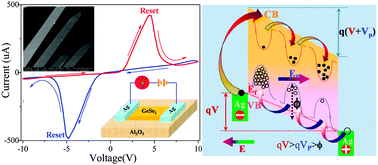Space charge polarization-induced symmetrical negative resistive switching in individual p-type GeSe2:Bi superstructure nanobelts for non-volatile memory
Abstract
Layered GeSe2 nanobelts doped with Bi have been synthesized by thermal reduction of Bi2Se3 nanopowder using germanium (Ge). The nanobelts prepared showed excellent p-type conductivity, with hole mobility as high as 690 cm2 V−1 s−1. The introduction of Bi leads to the formation of a commensurate superstructure, and induces the growth of nanobelts along the [010] direction. Two-terminal devices, based on individual GeSe2:Bi nanobelts with Ag electrodes, showed symmetrical resistive switching (RS) behavior accompanied by negative differential resistance. A space charge polarization model has been proposed. For the doping of Bi, the ordered superstructure defects and variable valences create trap centers, in which charges can effectively be captured and stored to generate polarization effects under a relatively large applied electric field. Additionally, the relatively large negative RS window can further be utilized as a non-volatile resistance random access memory (RRAM). The superior stability, reversibility, non-destructive readout and good cycling performance of the nanodevices demonstrated that Bi-doped GeSe2 nanobelts have considerable potential in next-generation non-volatile memory applications.

- This article is part of the themed collection: 2015 Journal of Materials Chemistry C Hot Papers

 Please wait while we load your content...
Please wait while we load your content...